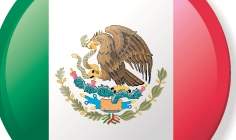
Mexico’s economy benefits from the pick-up in the US, which increases the momentum of its own recovery and the rise of its middle class, according to the Life Insurance in Mexico, Key Trends and Opportunities to 2018 report, available on the Insurance Intelligence Center
After Brazil, Mexico has the second-largest economy in Latin America, and the fourth highest GDP per capita after Chile, Brazil and Argentina. In 2009, Mexico’s GDP declined by 19.3% due to the financial crisis, which affected exports and foreign direct investment (FDI). However, the country is now in a phase of recovery and is expected to grow.
Contributing factors include an increased demand for Mexican exports in developed countries, an improvement in retail sales, industrial production and an increase in exports.
Almost 80% of exports are directed to the US. The US economic recovery is a good indicator of Mexico’s economic condition. At the start of the financial crisis in 2008, a sharp decline in trade contributed heavily to its GDP decline in 2009. Consequently, many US companies shifted production to China.
However, some are starting to return to Mexico due to its low manufacturing costs and geographical proximity.
This will create new employment opportunities and help support the country’s economy. In 2011, Mexico’s economy entered a period of recovery due to its focus on modernizing industry and an increase in exports.
How well do you really know your competitors?
Access the most comprehensive Company Profiles on the market, powered by GlobalData. Save hours of research. Gain competitive edge.

Thank you!
Your download email will arrive shortly
Not ready to buy yet? Download a free sample
We are confident about the unique quality of our Company Profiles. However, we want you to make the most beneficial decision for your business, so we offer a free sample that you can download by submitting the below form
By GlobalDataIts GDP at current prices grew at a rate of 17.1% and 12.0% in 2011 and 2012, respectively. In 2013, it stood at MXN15,003bn (US$1,177.2bn).
Growth in the telecommunications, media and banking industries will support economic growth and create further employment opportunities. Reforms such as the Oil Bill, passed in December 2013, opened up the oil industry to foreign investment and are expected to attract foreign companies.
This will create employment and boost disposable income. Credit rating agencies such as Moody’s and Standard & Poor have lifted Mexico’s credit rating; Moody’s from Baa1 to A3 in February 2014, while Standard & Poor assigned a BBB+ in December 2013.
These ratings are expected to increase the confidence of potential foreign investors.
In 2013, Mexico and China signed the ‘Tequila Agreement’ to enhance bilateral trade. It laid foundations for the export of tequila and Mexican pork to China. In return, China will invest in infrastructure projects in the mining and energy industries.
With the energy sector opening up, many countries are interested in investing in the country. The Mexican state oil company, Pemex, which enjoyed a state monopoly, has been opened for private partnerships in August 2014.
In May 2014, the Government of Singapore’s Investment Corporation showed an interest in investing in Pemex and other public sector companies of Mexico.
Pemex announced that it is in talks with Chinese companies to create a Sino-Mex Energy Fund of MXN51.3bn (US$4.0bn). It will be used to finance large-scale infrastructure projects in Mexico.
The prospective Sino-Mex Energy Fund will be the largest Chinese investment fund in the Latin American region.
Positive impact
These investments by foreign countries are expected to create employment opportunities in the country and improve living standards. This will indirectly have a positive impact on the life insurance industry as people will have more disposable income and are more likely to purchase or invest in insurance products.
Despite the difficult economic environment, the insurance industry has expanded significantly since 2009, growing at a CAGR of 9.8% in terms of gross written premium.
The growth was partly due to the robust regulatory environment, rising middle-class population and favourable demographic dividend, which is evident from the fact that the working-age population (15-65 years) has increased from 54.4% in 2008 to 56.2% in 2012.
Introduction of innovative insurance products, expansion of the bancassurance channel, growth in micro-insurance and foreign participation also contributed.
Mexico has the second largest insurance industry in Latin America, accounting for 14.5% of the region’s total premiums.
Despite sustainable growth, penetration remained relatively low at 2.2% in 2013. This was lower than the regional average of 3.0% and other Organization for Economic Co-operation and Development (OECD) countries, with an average of 5%. The low penetration rate provides investors with ample growth opportunities.
The regulatory body, Comisión Nacional de Seguros y Fianzas (CNSF), has made several amendments relating to insurance provisions and is working towards implementing the principles and concept of the EU’s Solvency II regime by 2015.
This is likely to enhance the industry’s operational efficiency. Although Moody’s believes that the regulatory changes will not have a significant impact on the development of the industry, they will demand more sophisticated internal risk management and increase the capital requirement of insurers, which is expected to lead to consolidation.
To modernize and to effectively regulate the industry, a new law, the Insurance and Surety Companies Law, is being introduced.
This law will be effective from April 4, 2015 and will replace the existing General Law of Insurance and Mutual Companies.
This law will introduce a number of new regulations: Regulations for new solvency standards via the implementation of a Solvency II type regime; the transfer of authority in several regulatory matters from the Ministry of the Treasury and Public Credit to the National Insurance and Bonding Commission; introduction of a new product line: guarantee insurance (seguro de caución); as well as new procedures for the liquidation and dissolution of insurance companies.
Industry size
The industry’s gross writ ten premium increased from MXN238.3bn (US$17.6bn) in 2009 to MXN346.3bn (US$27.2bn) in 2013, at a review period CAGR of 9.8%.
The non-life segment accounted for 38.8% of this, worth MXN134.4bn (US$10.5bn) in 2013, while personal accident and health accounted for 15.0%, or MXN51.9bn (US$4.1bn).
Life insurance was the largest segment, accounting for 46.2%. Led by sustained economic growth and favourable demographic dividends, especially the rising middle-class population, the segment expanded at a CAGR of 11.2%, increasing from MXN104.7bn (US$7.7bn) in 2009 to MXN159.9bn (US$12.5bn) in 2013.
This growth was higher than the average GDP growth of 1.8% during the same period. The segment’s penetration rate also increased from 0.86% in 2009 to 0.99% in 2013.
A growing economy, increasing annual disposable income, low penetration, increasing awareness of the benefits of life insurance, and greater innovation in life insurance products are expected to contribute to further growth.
Demand was particularly strong for products with protection and savings components such as pension and endowment.
From the diverse range of life insurance products, the pension and term life categories registered the highest CAGRs of 24.9% and 12.4% respectively.
Expect consolidation
As of 2013, 48 life insurers were operating in the life segment. Foreign companies dominated the segment, accounting for 60% of life insurance premiums in 2013. The segment is also highly concentrated, with the five leading life insurers accounting for 70.5% of the total premium income in 2013.
MetLife México was the leading life insurance company in 2013 with a 29.6% share. Fierce competition exists among the smaller life insurers. The life segment is expected to further consolidate over the forecast period due to increasing competition and the introduction of solvency rules comparable to Europe’s Solvency II.
Pensions are driving life insurance
Several demographic factors are driving demand for life insurance. Life expectancy increased from 75.6 years in 2007 to 76.5 years in 2011, and is estimated to increase further to reach 77.4 years by 2016.
The proportion of the population aged 65 years or over was around 6.7% of the total population in 2012, and is expected to increase further. An increase in the working age population (15-65 years) from 54.4% in 2008 to 56.2% in 2012 also contributed to the robust growth of pension and retirement products.
For life insurers, innovation in pension plans will increase their market shares in these categories.
Low penetration
The life insurance penetration was 0.92% of the country’s GDP in 2012, which is low even by Latin American standards of 1.3% in 2012 and signifies an opportunity for product and distribution channel growth. International players have positioned themselves well to benefit from the opportunities.
New foreign insurers are entering into the life segment; for example, in April 2013, Grupo Valores Monterrey, a domestic life insurer, was acquired by Sura Asset Management, a division of the Colombian financial group.
Awareness programmes
A lack of proper insurance knowledge hinders the growth of the industry. Insurance contracts were historically purchased by upper and middle income people with better financial knowledge.
Several skill sets, such as data analytics and underwriting, are in short supply, compelling the recruitment of this talent from universities and other industries.
Since 2012, the Mexicana de Instituciones de Seguros (AMIS) AMIS is calling for university students across the country to participate in the design of programs to create awareness of the importance of being insured.
Students can either participate individually or form a team of up to three members. Students can compete in
various categories such as video campaigning, comprehensive campaign, podcasting and web infographics. AMIS is also awarding prizes to the winners of the competition.
There is also a perceived need for innovation in both product design and distribution. Insurers are focusing on designing products to cater to the insurance needs of the low income population and developing products such as agriculture insurance.
High poverty and unemployment remain the main challenges facing the life insurance segment.
Poverty
Poverty is one of the major challenges the country is facing. The number of Mexicans on the poverty line increased from 47.8% in 2008 to 52.3% in 2012.
In addition, disposable incomes are low: In 2011, the gross national disposable income stood at MXN13,609.8bn (US$1,095.5bn) compared to Brazil’s MXN25,889 (US$2,083.9bn) in the same year. While Mexico is the second largest economy in the Latin American region after
Brazil, low gross national disposable income is posing a major challenge for the growth of the country’s life insurance segment.
Distribution
Mexican life insurers employ a diverse range distribution channels to cater to the different needs of customers.
The main distribution channels for life insurance products are direct marketing, bancassurance, agencies and brokers. Agencies and direct marketing channels were the most popular distribution channels for life insurance products.
During 2009-2011, bancassurance occupied the highest market share in terms of gross written premium from new business and number of policies sold.
The popularity of the bancassurance channel is primarily due to the presence of large financial institutions in the industry and other insurers entering into agreements with leading banks to sell their products. It was a popular channel for distributing pension products and other savings-type life insurance products with post-retirement benefits.
Banks played an important role in the establishment of pension funds in Mexico during the late 1990s and
many foreign companies that entered Mexico did so in partnership with local banks.
Some of Mexico’s largest insurers, such as Seguros Inbursa and Seguros Banamex, are subsidiaries of banking groups. Bancassurance’s popularity was driven by the competitive advantage held by banks over other distribution channels, as their strong network of branches and client base enabled them to offer products across all segments.
The popularity of bancassurance started declining from 2012 and at the same time the market share of agencies and direct marketing started increasing.
In 2013, in terms of gross written premium, the market share for agencies was 33.7% which is followed by direct
marketing with a 32.1% share.
Bancassurance stood in third place with 21.8% in 2013. The increase in the market share of agencies is mainly attributed to an increase in the number of players in the industry from 10,453 in 2009 to 13,129 in 2013.
The share of the agencies channel is expected to reach 37.6% in 2018. Agency networks have close relationships with insurers and pension providers and operate according to the insurers’ interests.
Agencies have a wide geographical reach and network of agents, making it an efficient and affordable channel for product distribution. The channel also offers insurance companies a large client base, strong brand reputation and
an existing sales force at a relatively low cost.
The second largest distribution channel in 2013 was direct marketing, which involves direct communication between the client and company.
The number of policies sold via direct marketing channel increased from 529,938 in 2009 to 1.02m in 2013, recording a market share of 32.1% in 2013. Over the forecast period, this share is expected to decrease slightly to 31.2% in 2018.
In terms of gross written premium for new life business, the market share of this channel increased from 20.4% in 2009 to 32.1% in 2013.
This growth is mainly due to insurers spending more on direct marketing as it helps businesses in interacting with potential customers directly.
Although e-commerce ranked last in terms of gross written premium for new life business during the review period, it recorded the fastest growth, growing at a CAGR of 28.6% during the review period.
It is expected to grow further at a CAGR of 26.3% over the forecast period. This is mainly attributed to the increase in the number of internet users in the country. As of 2013, there were 56.5m internet users out of a total population of 116m. Smartphone penetration in Mexico is also increasing which is evident from the fact that as of 2013 41% of the total population has been using Smartphone.
Agencies and direct marketing are expected to remain the major distribution channels over the forecast period.
The combined share in total commission earned is expected to reach 67.2% by 2018.
New strategies by major companies will include cost-control measures, achieving economies of scale, and increasing transparency to restore consumer confidence.







